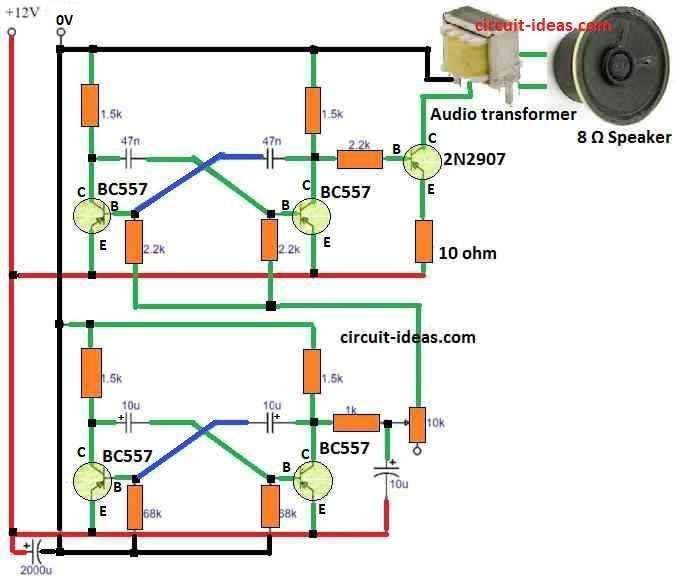Chirping Bird Sound Generator Circuit is small electric circuit that make sound like bird chirping.
It uses few parts and easy to make.
People use it for fun, in toy birds or doorbell.
It makes place feel like nature with bird sound.
What is Chirping Bird Sound Generator Circuit:
This small circuit make sound like real birds chirping.
We can enjoy bird sound anytime and anywhere.
Many people use this circuit to make plastic birds look more real or make doorbell sound which is more nice.
Inside it have two astable multivibrator work together and they make warble sound like real bird singing.
If we want nature sound in our life then keep reading and learn how this bird sound circuit work.
Circuit Working:

Parts List:
| Component | Quantity |
|---|---|
| Resistors (all resistors are 1/4 watt) | |
| 1.5k | 4 |
| 2.2k | 3 |
| 68k | 2 |
| 10Ω | 1 |
| 1k | 1 |
| Potentiometer 10k | 1 |
| Capacitors | |
| Electrolytic 10µF 25V | 3 |
| Electrolytic 2000µF 25V | 1 |
| Ceramic 47nF | 2 |
| Semiconductors | |
| Transistors BC557 | 4 |
| Transistor 2N2907 | 1 |
| Any standard audio output transformer | 1 |
| 8Ω speaker | 1 |
This bird sound circuit uses two astable multivibrators.
One make the bird tone and other make it repeat again and again.
First part is tone oscillator it makes the main bird sound.
The tone change every half cycle.
We can change the sound by moving VR1 which is a variable resistor.
Tone Formula:
Tone (f) = 0.693 / (R1 + 2 × (R2 + VR1)) × C1
here:
- f is tone frequency
- R1 is first resistor
- R2 is second resistor
- VR1 is variable resistor
- C1 is capacitor
To change the tone we need to use 10k variable resistor and 2.2k resistor in base.
We can also change sound by changing capacitor between collector and base.
Second part control how fast chirp sound repeat and for that we can also use a formula.
Repeat Rate Formula:
R = 0.693 / (R3 + R4) × C2
where:
- R3 and R4 are resistors
- C2 is capacitor
To make sound smooth a 10uF capacitor connects from potentiometer to ground and this shapes the square wave better.
One more capacitor is added to make special bird warble sound and this make sound last longer and feel more real.
Power supply also changes tone a bit but we can fix that by changing VR1.
Even with different power voltages circuit will still work fine.
Also a capacitor is put across transformer to remove a bad noise.
This bird sound circuit work better and give more control than other complicated circuits like blocking oscillator.
Advantages and Disadvantages
Advantages:
- This circuit can be used in funny plastic birds, car horns and doorbells.
- We can make different bird chirp sounds by changing tone and repeat speed.
- It is simple to use and works well with many power supply voltages.
Disadvantages:
- Sound is not 100% like real bird but just copy bird chirp in simple way.
- Tone changes if power voltage changes and so we may need to adjust it time to time.
Conclusion:
Everyone will enjoy using Chirping Bird Sound Generator Circuit in their electric projects.
We can use it for fun doorbell sound, cool car horn or make toy birds sound like real one.
It brings small nature sound into our daily life.
No need to worry try this fun project and enjoy bird chirping anytime!
If anyone have question or idea they can write in comment box.
We are happy to help on your bird sound journey circuit!
Leave a Reply